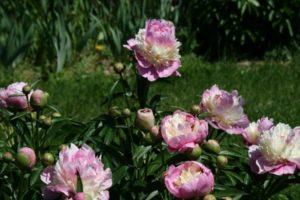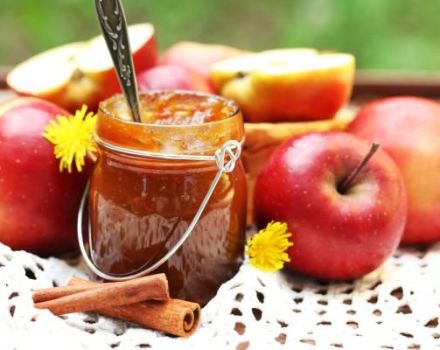Description of TOP 50 best and new varieties of peonies with characteristics
Many gardeners grow these spectacular perennial flowers on their backyards. There are about 34 species in the genus of Peonies, and there are more than 5000 varieties. Most of them are herbaceous varieties, and only 500 are tree-like. Of all the varieties of peonies bred by breeders, everyone will be able to choose a specimen to their taste, suitable for the climatic features of the region.
Content
- 1 What are the types of peonies
- 2 The best varieties
- 3 Pink flowers
- 4 White peonies
- 5 Red varieties
- 6 Yellow flowers
- 7 Burgundy varieties
- 8 Violet, lilac and magenta
- 9 Blue and blue
- 10 Black peonies
- 11 Orange varieties
- 12 Cream varieties
- 13 Raspberry peonies
- 14 Beige flowers
- 15 Early varieties
- 16 Late species
- 17 New varieties
What are the types of peonies
Regardless of the color of the petals, and it varies from snow-white to deep burgundy, all peonies are divided into 5 groups:
- The first group includes non-double flower varieties with no more than 10 petals. They are arranged in one or two rows, and in the middle there are pistils surrounded by stamens. A characteristic feature of the group is straight and strong stems.
- The next group is anemone peonies. Usually there are 5 petals in the bud, but there may be more, they are located in 2 or 3 rows. The stamens of these flowers are modified, they completely fill the middle of the bud.
- Japanese peonies are a transitional type from a simple flower to a double flower. The modified stamens are petal-shaped, in some cases they are bent downward, thus forming a pillow. The shade of the stamens is contrasting with respect to the petals or the same (pink, yellow, red).
- Semi-double varieties are characterized by five or more petals. Their stamens are modified, normally developed and petal-shaped. Arranged in a ring, they alternate with each other. A characteristic feature of all varieties of this group is a long-lasting fresh look when cut.
- The flowers of the double group have more than 5 petals, they are quite wide. In most double varieties, the stamens are modified into petals, however, there are varieties with normally developed pistils and stamens, hidden petals.
Another classification is carried out according to the flowering periods of peonies: early, medium early, medium, medium late, late, very late.
The best varieties
Over the decades of growing peonies, gardeners have identified the most beautiful varieties that are always popular.
Among them:
- Sarah Bernhardt. The variety was bred back in the 19th century, but still has not lost its popularity. The raspberry-pink buds are about 20 cm in diameter and exude a light, pleasant aroma during the flowering period, which begins in the second half of June. The bushes of the variety are tall and strong, they do not need a garter when growing, since the stems are strong and do not lean to the ground under the weight of the buds.
- The Qiao sisters.One of the rare and amazing varieties, its peculiarity is the two-color shade of the petals. One half is colored purple red and the other half is creamy white. The diameter of the bud of this variety is about 16 cm, and the height of the bush is within 120-130 cm. The flowering period is in June.
- Pastel Splendor. The variety belongs to ITO-hybrids and does not exceed 70 cm in height. The bush is compact, neat, therefore it is suitable for growing in small flower beds. The diameter of the bud is about 16 cm, on one bush there are up to 70 of them. The color of the petals is cream, pink or white, the core is bright yellow. During flowering, peonies exude a pleasant and light aroma.

Pink flowers
Among the peonies with pink petals, representatives of all groups are found. The most popular ones are:
- Solange. This spectacular variety was bred by French breeders a century ago. The bud does not exceed 18 cm in diameter, and the petals are pastel cream and pale pink in color. It is possible to grow this variety of peonies in almost any region, since the plant is resistant to the vagaries of the weather and has a high immunity.
- Ballerina. One of the representatives of the early flowering group, the first buds bloom in the last days of May. Ballerina was bred by a breeder from America. The diameter of the flower varies between 14-16 cm, and the height of the bush does not exceed 80 cm. In the first days of flowering, the terry petals have a creamy tone with a greenish tint, and then become snow-white.
- Madame Butterfly. The variety belongs to the Japanese group with an average flowering period. The diameter of a bud with crimson-pink petals is within 15-16 cm. The height of a perennial bush does not exceed 100 cm. Its stems are strong and have a curved shape. For cultivation, it needs a well-lit area, in extreme cases, a small partial shade is suitable.
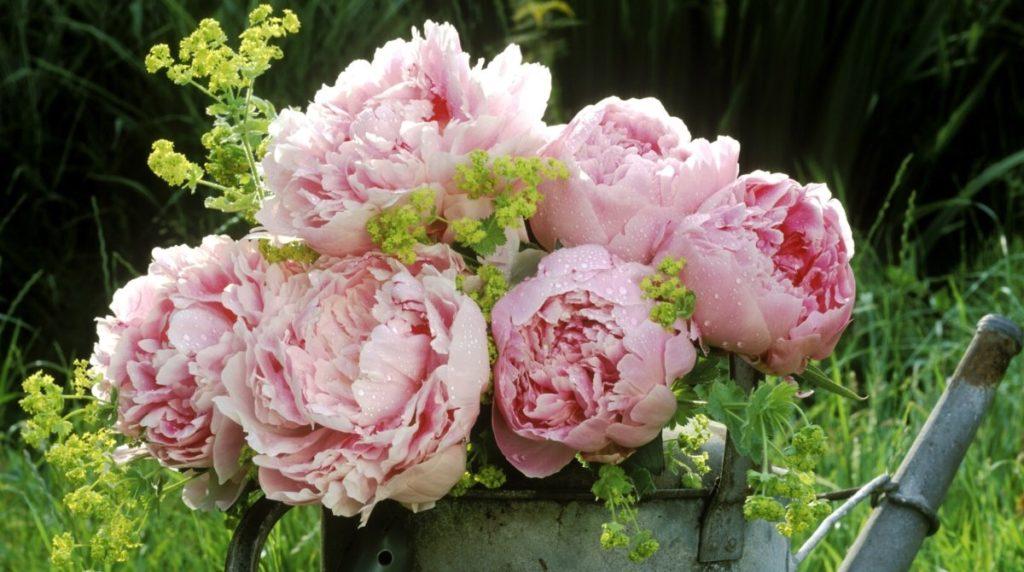
White peonies
Against the background of green lawns, peonies with white petals look especially impressive. In this group, there are many varieties for any climatic region, so there are no problems with the choice.
The most famous:
- White Crane. The variety is bred by Chinese breeders and is characterized by large buds. Withstands frosts down to -40 degrees, but requires a well-lit area in the summer. Its height does not exceed a meter, and the diameter of the buds is about 15-16 cm.
- Charles White. Luxurious flowers exuding a pleasant aroma were first introduced to gardeners in 1951. The bushes are large, they are spreading, therefore they need to be installed. The first milky-colored buds are formed in the last days of May, the flowering period of the buds lasts about 3 weeks. Each flower is 17 cm in diameter and is ideal for creating bouquets.
- Anne Cousins is white. The rose-like terry variety belongs to the group with the latest flowering date. Large buds (about 20 cm in diameter) are on strong, curved stems. The height of the bush does not exceed 90 cm.
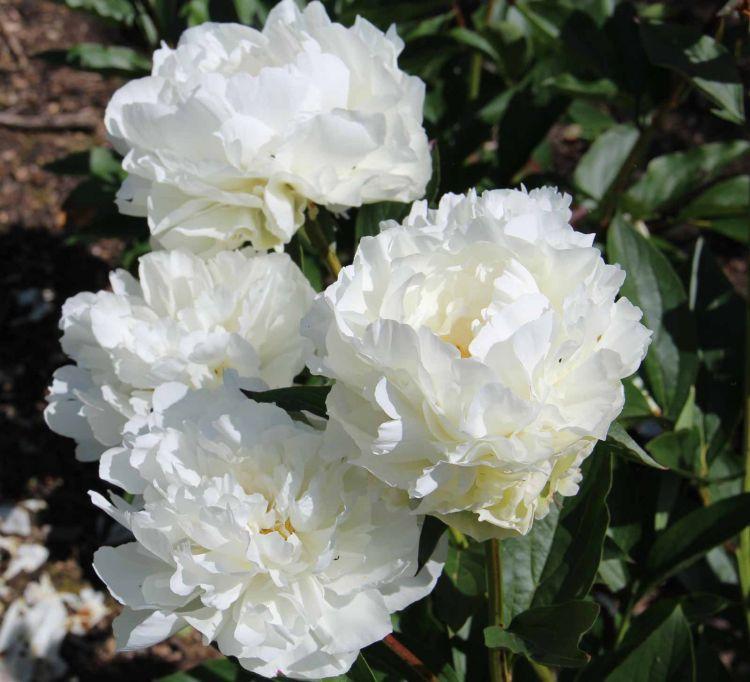
Red varieties
It is not for nothing that peonies are called the imperial flower, and specimens with red petals confirm this truth. Their spectacular appearance allows you to use flowers not only as a decoration for the site, but also in the form of bouquets.
The most popular varieties of this group are:
- Red Charm. A variety of herbaceous peonies characterized by semi-double flowers. The flower stalks, despite their height of 80 cm, are quite strong and stable, so the bush does not need a garter. The petals have a deep dark red hue.
- Moscow. Long flowering and pleasant aroma are the main advantages of the variety of domestic selection. Another advantage is its compact size (up to 55 cm in height), which makes it possible to grow it even in small garden plots. Cup-shaped buds are 10 cm in diameter, bloom in June and delight with colors for a month. The color of the petals is scarlet red.
- Ruth Clay. The herbaceous variety belongs to the mid-flowering peonies. Bred by American breeders.The color of the petals of a 13-centimeter bud is saturated red, almost burgundy. The flower has a pleasant, unobtrusive scent.

Yellow flowers
Peonies with a yellow shade of petals were bred by breeders not so long ago, but have already gained popularity among gardeners and landscape designers.
The most prominent representatives of the group are:
- Golden Wheel, developed by Chinese breeders. The correct crown-shaped buds are 15 cm in diameter. The petals are painted in an unusual shade of lime. Flowering period is late.
- Lemon Griffon, characterized by a compact bush and globular double buds up to 22 cm in diameter. The shade of the petals is pale yellow.
- High Noon with sun-yellow buds, which have a rare pink shape. Flowering is abundant, long-lasting, with proper care, the last buds open in August.
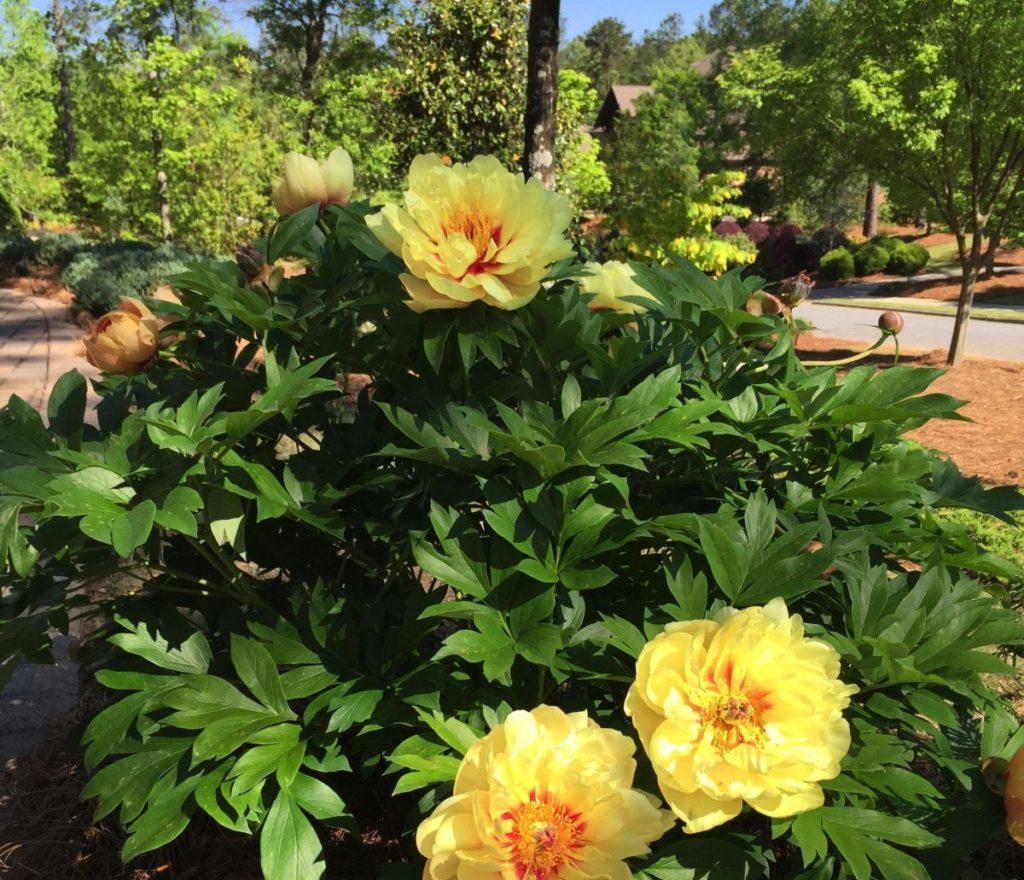
Burgundy varieties
Peonies with burgundy petals are a bright accent of any flower bed. The most famous varieties:
- Akron, reaching a meter in height and having elongated petals of a carmine-red hue.
- Angelo Cobb Freeborn with double inflorescences, having an early flowering period and stem length up to 90 cm.
- Chokelite Soulde, belonging to interspecific hybrids, characterized by dark cherry petals with a light chocolate undertone.

Violet, lilac and magenta
Among the varieties with lilac, purple and purple petals are:
- Duck Black Ash.
- Bowl of Beauty.
- Bellville.
- Anastasia.
- Purple Ocean.
- Black Crown.
- Purple Lotus.
- Blue Sapphire.
- Alexandr Duma.

Blue and blue
The breeders have not yet been able to breed peonies with a blue or blue shade of petals. There are varieties with a slight shade of this color scheme.
These include:
- Blue Ball.
- Blue Doe.
- Blue Lotus.
- Blue bird.
- Heavenly Brocade.

Black peonies
Among the varieties with dark, almost black petals, the following are grown:
- Black Panther.
- Chocolate Soldier.
- Black Boy.
- Sacred Mountain.
- Black dragon.
- Highlight.
- Black Hydrangea.
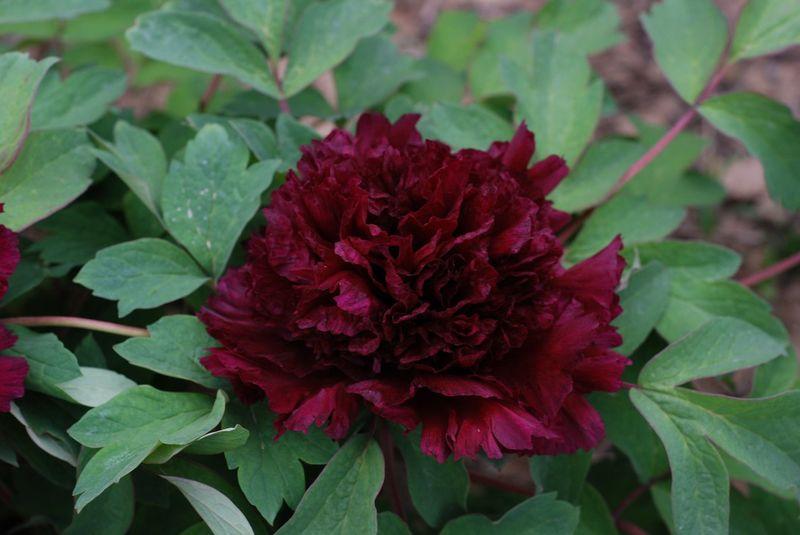
Orange varieties
These amazing varieties have deep orange petals. There are few of them, but among the best it is worth highlighting:
- Coral Charm.
- Lorelei.
- Coral Sunset.
Cream varieties
The delicate creamy shade of the petals allows you to create harmonious compositions in flower beds with other flowers. The most popular varieties are:
- Joanna Marlene.
- Le Printemps.
- Canary Brilliant.
- Pastelegance.

Raspberry peonies
The deep raspberry color of the peony becomes an accent on a flower bed with other plants.
Such specimens are planted as:
- Alexander Fleming.
- Kansas.
- Karl Rosenfeld.
Beige flowers
The following varieties are characterized by beige petals:
- Bridel Ising.
- Claire de Leune.
- Duchesse de Nemours.

Early varieties
For gardeners who prefer early varieties of peonies, the following varieties are suitable:
- Ellen Cowley.
- Nancy.
- Cytheria.
- Larto.
- Prairie Moon.
- Buckeye Bell.
- Miss America.
Late species
Late varieties that bloom before the first cold snaps include:
- Arkady Gaidar.
- George Peyton.
- Anshantress.
- Gladys Taylor.
New varieties
Breeding work on the development of new varieties continues today.
Among the new products are the following:
- Buckeye Belle.
- Big Ben.
- Vivid Rose.
- Garden Treasure.
- Glory Hallelujah.
Each species has its own requirements for growing conditions, so this is taken into account when purchasing plants.

